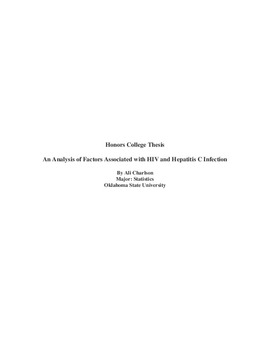| dc.description.abstract | Human Immunodeficiency Virus (HIV) and Hepatitis C Virus (HCV) are both potentially life threatening diseases when left untreated. The two diseases are spread in a similar manner, and it is possible that the factors associated with having HIV, HCV, or both are also similar. This project aims to examine factors that could be associated with people diagnosed with HIV, HCV, or both diseases using statistical techniques on data from a sample region in China with high HIV and HCV prevalence rates, collected from May 2004 to September 2012. The first goal of the project was to identify potential factors associated with coinfection rates of HIV and HCV across China, and analyze in what proportion of population those factors appeared. This was done using RxC contingency tables and Pearson's Chi-square Test on each individual variable in the data set. Every variable from the data set was found to have a statistically significant association with the ordinal levels of coinfection rates of HIV and HCV. Every p-value was less than .05, with most of the p-values also being less than .01. Thus, for every variable we reject the null hypothesis that the variable is independent from different levels of coinfection rate, meaning that all variables in the data set are at least somehow associated with contraction of one or both diseases. The second goal of the project was to examine possible predictors of infection with HIV and HCV. In doing so, meaningful comparisons can be made between predictors associated with either disease. Logistic regression was used to create the two separate models with HIV and HCV as separate response variables. Forward stepwise regression was then used for the variable selection process. For the HIV model, all levels of education, drug injection behavior, and marital status were found to be significant predictors of having HIV. Odds ratios were used to interpret these results. The final model was calculated with n = 3,495 and had an AIC value of 3,229.9, which was the lowest of all possible models evaluated. For the HCV model, participation in a rehabilitation program and completing college education were found to be the only significant predictors of having HCV. The final model was calculated with n = 3,246 and had an AIC value 3,922.8 which was relatively lower than the AIC for the other models. Odds ratios were again used to interpret the results. Comparing these models and variables is useful for the study of patients who may be at risk for contracting these disease, or who have already been diagnosed with one or both diseases. Changes in any of these variables could ultimately predict the contraction of an additional new disease, and trying to control or prevent these changes could help many people from being diagnosed with a second difficult to manage disease. HIV and HCV are two very serious problems that require immediate and aggressive treatment. The more information that healthcare professionals have about who is at risk for HIV and HCV, the more opportunities there are for preventive measures and resources to be put into place. | |
